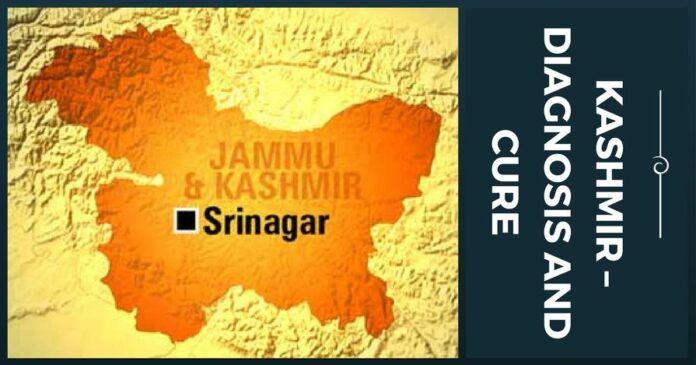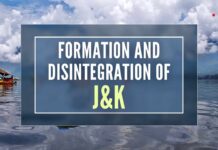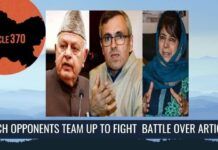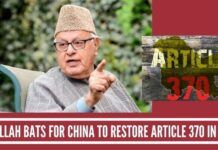
For India, Kashmir is a symbol of her secular identity and the only window that opens towards Central Asia
The geopolitics of British India in 1947 has emerged as the most important discourse for the contemporary India and the subsequent expansionist intent of Pakistan to annex Kashmir in 1948 to realign the geographical boundaries laid the foundation for the ongoing proxy war in the State. The indelible factors of ‘religion’ and ‘location’ reinforce the geopolitical significance of J& K and its strategic importance have feuded the seven decades of animosity between India and Pakistan. For India, Kashmir is a symbol of her secular identity and the only window that opens towards Central Asia. From Paks’ perspective, the Two Nation Theory insinuates the Muslim majority of Kashmir to Islamic Pakistan. It also provides them with the much-desired land access to China.
Responsible journalism must be enforced if not willfully enacted so that secessionist voices don’t get centre stage and unwanted international sympathy
Independence of India and Pakistan was a chaos, abetting the conflict and hatred amongst those who once joined hands to fight against the British Raj. At the time of partition, Princely states were a peculiar issue – they were technically free to accede to either dominion or remain independent; however, sovereignty was only a theoretical option.
The mistake of Maharaja Hari Singh, the Hindu ruler of Muslim majority state, to remain independent humiliated the Islamic identity of Pakistan and the consequent war of 1948-49 made Kashmir the longest running agenda at the United Nations. India claimed the state after Hari Singh signed the instrument of accession, but for Pakistan, it still remains the unresolved issue of the Partition.
One of the core reasons for this protracted instability is the ‘special status’ Kashmir enjoys in the Constitution and Governance; that makes the State elusive of National reality and mainstream India. Harsh that it might sound, but the bane for Kashmir ‘is’ and ‘has’ been the infamous Article 370, obfuscated under layers of misleading conveniences and privileges. Article 370 is a Constitutional document codifying the bargain between Nehru’s failed promise of Plebiscite and Sheik Muhammad Abdullah’s ambitions to rule the State. The ‘Temporary Provisions’ of the Article have survived generations of illogical policy veiled behind the facades of a pseudo-Kashmiri nationalism. The near ‘Permanency’ of the Article suggested by the High Court of J&K and Mehbooba Mufti’s unflinching stand is the paradox of Modi’s manifesto of 2014 general election and argues the integrity of Kashmir’s territory.
Pseudo intellectuals, biased media and Pak financed ‘separatist outfit’ have carefully crafted the narrative of a Kashmiri struggle against India and Indian Army, who have been portrayed as invaders out to destroy Islam in Kashmir. Sustained religious propaganda and the ingenious modus operandi (such as stone pelting by unarmed mobs) has outflanked the strategies of successive Central Governments to bring normalcy in the State. The Hindutva and RSS characterization of BJP government, which is a coalition in State and absolute at Centre, further cripples any scope for reconciliation.
The Hindutva and RSS characterization of BJP government, which is a coalition in State and absolute at Centre, further cripples any scope for reconciliation
Over 4 lac Kashmiri Brahmins, the once respected Kashmiri Pandits, continue to live as refugees in their own country, in refugee camps of Jammu and Delhi in appalling conditions. The BJP manifesto of 2014 promised the return of Kashmiri Pandits to the land of their ancestors with full dignity, security and assured livelihood. However, it is far from reality and completely unattainable because of the alliance between two ideological extremes (BJP & PDP).
Pakistan has launched repeated conventional wars to occupy Kashmir but successfully failed each time. Later it adopted the grand design of a protracted low-intensity conflict to slowly bleed out India. Since 2008 there has been a change in the approach; misguided youth have been funded and aroused to organize mass upsurges based on the absurdness of Aazadi, fake ipseity of Burhan Wani and manufactured lies of Army’s cruelty. Indian Security Forces have been battling this Pak sponsored proxy war for last three decades and thousands of braves have sacrificed their lives, yet the political goals to define the military strategy have neither been formally decided not exemplified. Completely out of context and profile, the military has also been entrusted the responsibilities of winning hearts and minds and developing infrastructure, an errand objective for which it is neither trained nor organized.
Since a sound political strategy for Kashmir is never in sight because of its complexity, uniqueness and a slimy neighborhood; the intellectual proposal for a status quo and ‘Kadi Ninnda’ is being used as a shield for strategic indecision. The excuse of religious struggle and Jihad is merely the currency cover for the lack of political will.
There is never going to be a one line solution for Kashmir, but for any form of normalcy, the writ of the National law must prevail, and not Article 370. Laws on sedition must be enforced to starve the separatists propagating anti-national sentiments. Ideally, they should be ‘media isolated’ without curbing the freedom of the press. Responsible journalism must be enforced if not willfully enacted so that secessionist voices don’t get center stage and unwanted international sympathy.
The benevolence of Kashmiriyat guarantees harmonious coexistence of Hindus and Muslims, who have happily lived together for a very, very long time
By statistical, media and anecdotal accounts, Kashmir appears to be far away from peace and shall continue to remain a festering territorial dispute with Pakistan. The omnipresent political volatility in Pak, its overt radicalization and Talibanisation, affirms that it will continue with its nefarious design to harm India in every way possible. Any miscalculations or lowering of guard by Indian Security Forces will have to be paid with precious lives and reputation. Easier said than done, there is a need to review the threat holistically, evolve a 360-degree strategy of defence and offence; and more importantly, implement it without any political interference and knee jerk reactions.
Out of the 1,01,000 sq km of J&K, 86,000 sq km has no problem. It’s only the small area of Kashmir valley, i.e only 15,000 sq km, that has Terrorism and Separatism. Hence, the solution should be found in here. Under the present circumstances, Kashmiriyat is the only thing that promises peace and happiness for Kashmir. Academically it is the Ethnonational and social consciousness and cultural values of the Kashmiri people, but in reality, it is the awakening of the unsuspecting large neutral population, which is searching for peace and prosperity. The benevolence of Kashmiriyat guarantees harmonious coexistence of Hindus and Muslims, who have happily lived together for a very, very long time. It is the time that Shri Vajpayee’s doctrine of peace, progress, and prosperity for J& K; codified as Insaniyat (Humanity), Jamhuriyat (Democracy) and Kashmiriyat (Identity of the people of Kashmir) is made a reality.
Note:
1. Text in Blue points to additional data on the topic.
2. The views expressed here are those of the author and do not necessarily represent or reflect the views of PGurus.
- हिन्दू धर्म – एक तबाह अन्तः मन और उसके जीने का संघर्ष - August 17, 2017
- Kashmir – Diagnosis and Cure - August 16, 2017
- Hinduism – A Ravaged Soul and the Quest for Survival - August 13, 2017











The permanent solution for solving the Kashmir crisis is to think out of the box. See
https://thinkerspad.wordpress.com/2014/05/29/how-kashmir-is-bleeding-hindus/
Where were those so-called “True Kasmirias” and their “kashmiriyat” when, in a Notification of 1932, the J&K Maharaja’s government enlarged the definition of the concept of “State Subjects” enunciated in the Maharaja’s 1927 Notification, and thereby created an unbelievable discrimination between the rights enjoyed by two different categories of citizens? In fact, the 1932 Notification was (as cited by Justica Anand in his book on the J&K State Constitution) prompted by a “widespread” “protest by the people” demanding “protection of their rights against the superior interests of the non-residents of the State”. Are we to deduce then that those protesters were not “True Kashmiris”? And where were those “True Kashmiris” when, under Section 6 of its State Constitution of November 1956 denied a plethora of rights to those who did not meet the strict definition parameters of “Permanent Residents”? Really, its futile to romanticise today about the bygone “culture” of “kashmiriyat”, be it true or false. The truth is that all artificially created discriminations (Article 370 and Article 35A) between J&K State and the rest of India must be totally demolished—NOW, just now!
Thanks a million to Prof Hari Om for revealing the truth of the term “Kashmiriyat” and thereby exposing the likes of Atal Bihari Vajpayee who, in his emotional poetic naivete used the term in the late nineties and which is now frequently (too frequently) cited by Mehbooba Mufti, the current CM of the wretched, ungrateful J&K State. Vajpayee, the dreamer, was also guilty of clubbing that term with “insaniyat (humanity) and “Jamooriyat” (democracy) because, as said, he was a good but innocent man, who, unlike Narendra Modi, really had no clue of thew wickedness of Kashmiri Muslim rulers. And, alas, Ms Vasudha Acharya repeats that as a necessity for bringing peace and prosperity to J&K. She seems to have no clue about the damage caused to the J&K cause by Article 370, its facilitation for the creation of Article 35A as well as over a hundred “exceptions and modifications” introduced as Constitutional provisions into the J&K State by letting the President of India issue Executive Orders as being applicable only to the J&K State. Let it be remembered that these so-called “exceptions and modifications” of the Constitution of India WITHOUT being subjected to the Indian Parliament’s discussion and consent. And the defence has been that Article 370 permits that!. Yes it does, because Article 370 was so craftily scripted that the words preceding that Article’s contents says “Notwithstanding anything in this Constitution.” This meant, and means, that Article 370 of the Constitution of India is a stand-alone piece of our Constitution!! Which other democracy in the world gives such “Azadi” to just a small territory of that country?
The term Kashmiriyat was coined in 1976 by a Jammu-based Hindu journalist close to then Chief Minister Sheikh Abdullah. Kashmiriyat means Sunniyat, persecution, murder, conversion and exclusion of all Hindus, Sikhs, Buddhists and all non-Sunnis. It is the extreme form of Wahabism/Salafism. Ask Kashmiri Hindus, ask Ladakhi Buddhists, ask Hindus of Jammu, ask Hindu-Sikh refugees from Pakistan and ask the Hindu daughters of Jammu — all victims of Kashmiriyat –, they know what Kashmiriyat means to them.
Dear Prof.. value ur input, but i think there is some ambiguity about the era & context u r referring to Kashmiriyat..
Kashmiriyat (Kashmiri-ness) is the ethno-national, social consciousness and cultural values of the Kashmiri people. The concept emerged long back but developed approximately around the 16th century and is characterized by religious and cultural harmony, patriotism and pride we Kashmiris have for their homeland. Srinagar and the whole Kashmir valley was a citadel nestled securely between the lofty Himalayan range in the north and the Pir Panjal in the south. The 134-kilometer by 40-kilometer oval plane with its meandering rivers and rippling lakes, rolling greens and flower fragrant paths was a citadel of eden, a citadel for a way of life (having harmonious co-existsnce of religion) which the world today denies. True Kashmiris call it kashmiriyat.. You may look at surveys of last 50 yrs, around 70% kashmiri population has always been neutral. It is their Kashmiriyat that kashmir wants today.. thnks
PS– i have used a “we”.. unless we use “we”, we wont find a soln to Kashmir..